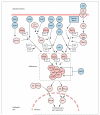Detection of enteric pathogens by the nodosome
- PMID: 24268520
- PMCID: PMC3943588
- DOI: 10.1016/j.it.2013.10.009
Detection of enteric pathogens by the nodosome
Abstract
Nucleotide-binding oligomerization domain protein (NOD)1 and NOD2 participate in signaling pathways that detect pathogen-induced processes, such as the presence of peptidoglycan fragments in the host cell cytosol, as danger signals. Recent work suggests that peptidoglycan fragments activate NOD1 indirectly, through activation of the small Rho GTPase Ras-related C3 botulinum toxin substrate 1 (RAC1). Excessive activation of small Rho GTPases by virulence factors of enteric pathogens also triggers the NOD1 signaling pathway. Many enteric pathogens use virulence factors that alter the activation state of small Rho GTPases, thereby manipulating the host cell cytoskeleton of intestinal epithelial cells to promote bacterial attachment or entry. These data suggest that the NOD1 signaling pathway in intestinal epithelial cells provides an important sentinel function for detecting 'breaking and entering' by enteric pathogens.
Keywords: Nod-like receptors; pathogen detection; patterns of pathogenesis; type III secretions system.
Copyright © 2013 Elsevier Ltd. All rights reserved.
Figures

Similar articles
-
Manipulation of small Rho GTPases is a pathogen-induced process detected by NOD1.Nature. 2013 Apr 11;496(7444):233-7. doi: 10.1038/nature12025. Epub 2013 Mar 31. Nature. 2013. PMID: 23542589 Free PMC article.
-
NOD1 and NOD2 signalling links ER stress with inflammation.Nature. 2016 Apr 21;532(7599):394-7. doi: 10.1038/nature17631. Epub 2016 Mar 23. Nature. 2016. PMID: 27007849 Free PMC article.
-
NOD1 and NOD2 of the innate immune system is differently expressed in human clear cell renal cell carcinoma, corresponding healthy renal tissue, its vasculature and primary isolated renal tubular epithelial cells.J Cancer Res Clin Oncol. 2019 Jun;145(6):1405-1416. doi: 10.1007/s00432-019-02901-7. Epub 2019 Mar 22. J Cancer Res Clin Oncol. 2019. PMID: 30903318 Free PMC article.
-
NOD1 and NOD2: signaling, host defense, and inflammatory disease.Immunity. 2014 Dec 18;41(6):898-908. doi: 10.1016/j.immuni.2014.12.010. Epub 2014 Dec 6. Immunity. 2014. PMID: 25526305 Free PMC article. Review.
-
The Nodosome: Nod1 and Nod2 control bacterial infections and inflammation.Semin Immunopathol. 2007 Sep;29(3):289-301. doi: 10.1007/s00281-007-0083-2. Epub 2007 Aug 10. Semin Immunopathol. 2007. PMID: 17690884 Review.
Cited by
-
Beyond the inflammasome: regulatory NOD-like receptor modulation of the host immune response following virus exposure.J Gen Virol. 2016 Apr;97(4):825-838. doi: 10.1099/jgv.0.000401. Epub 2016 Jan 13. J Gen Virol. 2016. PMID: 26763980 Free PMC article. Review.
-
Bacterial factors exploit eukaryotic Rho GTPase signaling cascades to promote invasion and proliferation within their host.Small GTPases. 2014;5:e28209. doi: 10.4161/sgtp.28209. Epub 2014 May 8. Small GTPases. 2014. PMID: 25203748 Free PMC article. Review.
-
Micropatterned macrophage analysis reveals global cytoskeleton constraints induced by Bacillus anthracis edema toxin.Infect Immun. 2015 Aug;83(8):3114-25. doi: 10.1128/IAI.00479-15. Epub 2015 May 26. Infect Immun. 2015. PMID: 26015478 Free PMC article.
-
Now you see me, now you don't: the interaction of Salmonella with innate immune receptors.Nat Rev Microbiol. 2015 Apr;13(4):206-16. doi: 10.1038/nrmicro3428. Epub 2015 Mar 9. Nat Rev Microbiol. 2015. PMID: 25749454 Review.
-
Role of Rho GTPases in inflammatory bowel disease.Cell Death Discov. 2023 Jan 23;9(1):24. doi: 10.1038/s41420-023-01329-w. Cell Death Discov. 2023. PMID: 36690621 Free PMC article. Review.
References
-
- Gewirtz AT, et al. Cutting edge: bacterial flagellin activates basolaterally expressed TLR5 to induce epithelial proinflammatory gene expression. J. Immunol. 2001;167:1882–1885. - PubMed
-
- Weber B, et al. Intestinal macrophages: differentiation and involvement in intestinal immunopathologies. Semin. Immunopathol. 2009;31:171–184. - PubMed
Publication types
MeSH terms
Substances
Grants and funding
LinkOut - more resources
Full Text Sources
Other Literature Sources
Research Materials
Miscellaneous

